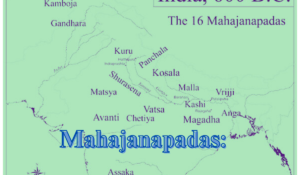Vedic period
Introduction:
The Early Vedic Period, spanning approximately from 1500 BCE to 1000 BCE, marks a crucial phase in ancient Indian history characterized by the migration and settlement of Indo-Aryan tribes in the northwestern regions of the Indian subcontinent. Structured around clans and ethnic groups, this era saw the emergence of a society where the king wielded limited powers and conflicts ensued between Aryan and non-Aryan tribal groups for territorial control. Despite the presence of the varna theory and Aryan identity pride, societal discrimination was not deeply ingrained. The predominant lifestyle was pastoral, with cattle-centered conflicts occurring regularly alongside the cultivation of agriculture. Archaeological findings highlight the production of diverse objects, showcasing the early technological and cultural developments of the time, including metalwork, wooden artifacts, pottery, and textiles. This period laid the foundation for the subsequent Vedic literature and cultural evolution in ancient India.
Literature in the Vedic period:
RigVeda – The Oldest Veda:
The RigVeda, the oldest of the four Vedas, is a collection of songs dedicated to various deities.Consisting of more than a thousand songs, it is a poetic expression of religious consciousness and cosmological speculations of the time.The songs are organized into ten books (mandalas), and each song is addressed to a particular deity, praising their qualities and invoking blessings.Although the Rig Veda is written in Sanskrit, it has identified 300 word words from Munda and Dravidian languages.
SamaVeda – The Veda of Melody:
The Sama Veda is unique for its musical element.It consists of a collection of melodies (saman) derived from the RigVeda and set to music.The importance of sound and rhythm in the Samaveda highlights the importance of music in Vedic rituals.Kirtans, when chanted or sung, were believed to have a powerful impact on the cosmic order.
YajurVeda – The Veda of Sacrificial Sutras:
The YajurVeda is closely associated with rituals and sacrificial rituals.It is divided into two parts: black Yajurveda (Krishna Yajurveda), prose mantras for rituals and white Yajurveda (Shukla Yajurveda), which combines the same mantras in a more metrically organized form.This scripture provides guidelines for the complex rituals performed by the priests.
AtharvaVeda – The Veda of Mantra Sutras:
The AtharvaVeda includes songs and mantras associated with the magical and practical aspects of life.It deals with everyday concerns including healing, safety and domestic rituals.The addition of practical knowledge distinguishes the AtharvaVeda from other Vedas and reflects a broader engagement with the anxieties of ordinary life.
Shrutis: Shrutis include brahmanas, aranyas and upanishads.They are considered sacred, fixed, and unquestionable truths. Pitch means listening. These were passed on orally to the next generations.
Brahmins and Aranyas:
Following the Vedas, the Brahmanas and the Aranyakas are prose texts that provide explanations and explanations of rituals.The Brahmins explore the ritual aspects and provide detailed guidelines, whereas the Aranyakas, often referred to as the “forest texts”, are associated with the most thoughtful and philosophical aspects of the Vedic tradition.
Upanishads – Philosophical Speculations:
The Upanishads, considered to be the culmination of Vedic thought, mark a shift towards philosophical inquiry.Written in prose, these texts explore deeper psychological questions, including the nature of reality (Brahman) and the self (atman).The Upanishads lay the foundation for the development of Hindu philosophy and are integral to the spiritual heritage of India.
Arrival Of The Aryans (Vedic period):
With the arrival of the Aryans, the vedic period began.The Vedic period is the period from 1500 BC to 600 BC in Indian history.The Aryans were herders who could migrate from the Indo-Aryan-speaking areas.they migrated in waves from central asia into the hindu kush mountains through the khyber pass .Their primary occupation is cattle rearing.They knew how to destroy and burn and cultivate agriculture.The Aryans of the Rig Vedic period were nomads whose main property was cattle.The Punjab was the abode of the Aryans of the Rig Vedic period and they lived in Sapta Sindhu, known as the land where seven rivers flow.The Indus and its tributaries – Jhelum, Chenab, Ravi, Beas, Sutlej and Saraswati.On the basis of the similarity of indo-Aryan languages, the Aryans originally supported the theory that they belonged to Europe.Around 1000 BC, the Aryans moved eastwards and settled in the Indus Gangetic plain.The people of the Rig Vedic period knew only about the metals of gold (hiranya), iron (siama) and copper (ayyas).
The Early Vedic Period (Rig Vedic Period):
The Rig Veda Samhita is the oldest book and is associated with the early Vedic period. Many scholars estimate that the early Vedic culture belonged to the period between 1500 and 1000 C.E.The early Vedic Aryans of the Indian subcontinent lived in parts of eastern Afghanistan, Pakistan, Punjab and western Uttar Pradesh.When the Aryans of the Rig Vedic period came to India, the Dasas clashed with the peoples known by the Aryans as Muscles (Dravidians), who were a black race.
Political System and Administration:
The rig vedic system of government is the politics of the tribal groups, and the leader of the tribes will take all the actions, he is the leader, he is rajan.During the Rig-Vedic period, the places and lands inhabited by people were referred to as jana, vish, kanaa and.He may also have been elected by a council called a work samiti.The Vedic society had a military character, with bows and arrows, axes and spears being used as important weapons of war, fighting for cattle and wealth.The Aryans fought not only with the non-Aryans, but also with themselves.They created gods for them and Indra was called ‘Purandara’.‘Purandara‘ means one who destroys the settlements.The chief of the tribe was called ‘Koba’ and ‘Gopati’, which means the head of the cattle.
There are three systems mentioned in the Rig Veda. The ‘Sabha’ is an organization of the elderly or the elderly, the ‘samiti’ is the place where people gather and vidhata is a group of groups.The clergy advised and encouraged the king and gained the influence of the kings. Senani was the commander of the army, the officer who controlled the territory was called ‘Virajapati’ and the head of the villages was Gramani himself.The people voluntarily paid taxes to the king, which was called a ‘sacrifice’.One of the ethnic groups of the Aryans was the Bharata clan and the surrounding areas were named ‘Bharatavarsha’.It was on this tank that the ‘Battle of the Ten Kings’ was fought, of which five were Aryans and five were non-Aryan kings.This battle was fought on the banks of the River Purushini. It is today’s Ravi River.
Social Organization of Vedic period:
The Aryans used the word ‘varna’ to denote colour and type to distinguish others from them.The Dasas and the Muscles were enslaved. Later they referred to them as Shudras and presented such Shudras as gifts to the priests.As stated in the ‘Purush-Sukta’ section of the Rig-Veda, many varnas have thus appeared. Those who originated from his mouth are said to be Brahmins, those born from two hands are satriyas, those born from the thighs are Vaishyas, and those who are born from the feet are said to be Shudras.Panis are those who get into carts where cows are locked and do business.
Families and Ethnic Groups:
The clans came together to form a ‘jana’ community, “jana” means tribe or community. The term occurs 21 times in the Rig Veda, emphasizing its importance.Interestingly, there is no word ‘Janapada’ in the RigVeda.The word ‘vish’, which refers to ordinary people, is mentioned 170 times in the Rig Veda, which underscores the importance of the general public in the social context.These people lived in villages, which refers to a decentralized settlement system as opposed to urban centers.The word ‘Griha’, which means family, is noteworthy, referring to the family as a basic social unit within the tribe.
Women of Vedic period:
The society being discussed was patriarchal, where men played dominant roles and greater importance was given to male children.Reflecting the social desire for male offspring, the birth of a male child was much desired and this option was extended to cattle as well.Society was militaristic, men had to engage in war and dominate the lands.Despite the patriarchal system, women enjoyed a respectable position and participated in village meetings and celebrations.Although marriage was in practice, ancient marriage methods were followed. Polygamy may have been common, and remarriage was a widespread practice.Scholars believe that marriages took place between the ages of sixteen and seventeen, indicating a relatively young age for marital relationships.Historians report that child marriages did not take place during this period, which highlights the difference from some historical practices.The head of the family is referred to as ‘Grahapati’, which refers to a person who is responsible for the leadership and well-being of the family.Grahapati’s wife is referred to as ‘Sabatini’, who plays an important role in the family structure and dynamics.
Agriculture:
Evidence of agriculture grown with tools such as ploughs, oxen, etcCrops such as barley and wheat are cultivated.The land is public land and not privately owned.
Animal Husbandry:
Important economic activity, livestock were valuable possessions.Cattle are often used as a gift or as an offering to priests.The pastoral economy is more important than land ownership.
Craftsmanship:
Various skilled industries such as woodworkers, metalworkers, weavers and leather workers.Copper and bronze metal were widespread.Iron has not yet been used during this period.
Trade and Exchange:
Not in abundance, but there were merchants (banis).Barter was the main form of exchange and was used as a coin with gold/silver ornaments (nishka).The priests offered horses and nishkas to the rituals.The distribution of cows encouraged animal husbandry and economic development.
Transportation Vedic period:
Horses played an important role in transport during the Rig Vedic period.Bullock carts and horse-drawn carriages were commonly used for land transport.References to the sea (ocean) and boats (nav) refer to maritime activities.It is to be noted that boats operated by 100 oars that showcase advanced maritime technology have been mentioned.
Vedic period Religion and Rituals:
The Vedic society attached significant importance to religion and rituals.The RigVeda represents a system of natural and multi-deity beliefs in which natural forces such as the sun, moon, rivers, mountains and rain are considered divine.Indra played an important role as the most important deity, also known as ‘Purandara’.Fire was regarded as an ambassador that unites the gods and the people who remove darkness.Goddess ‘Usha’ was revered as the goddess of dawn.Other deities include Aditi, Prithvi, Seenivali, Varuna (god of water) and ‘Soma’ (god of plants).The rituals described the consumption of intoxicating liquor and the methods of preparation of the songs in the RigVeda.Marud was associated with god strength and had some references in rudra (or Shiva) texts.Rituals were performed to meet the daily challenges, and the clergy played an important role in vedic society.
Conclusion:
Early Vedic society was structured around clans and ethnic groups, with little power of the king. Aryan tribes and non-Aryan tribal groups engaged in wars for control of territories. Despite the varna doctrine and pride of Aryan identity, social discrimination was not deeply rooted. Pastoral life, with daily conflicts centered on cattle and animal husbandry. The method was significant. Agriculture also played an important role in the society of the Early Vedic period. Archaeological evidence reveals the production of various goods, including metal objects, wooden objects, pottery and textiles.




Pingback: Later Vedic Period ,Culture,Transaction,Economy,Administration